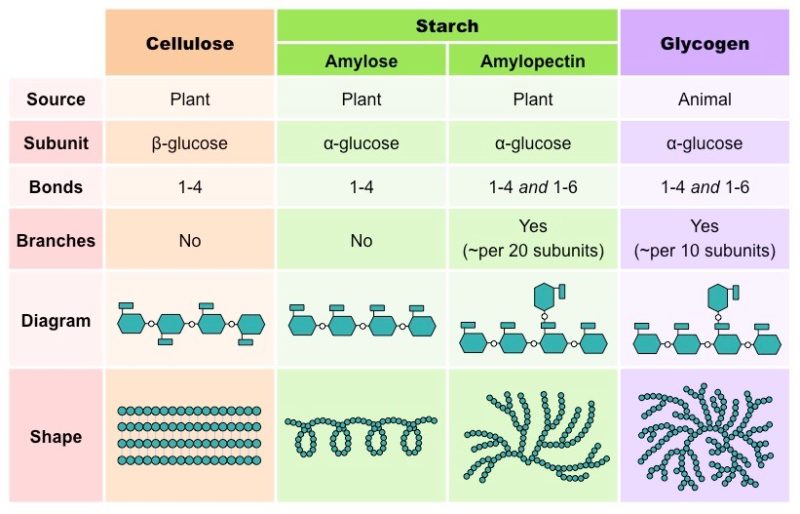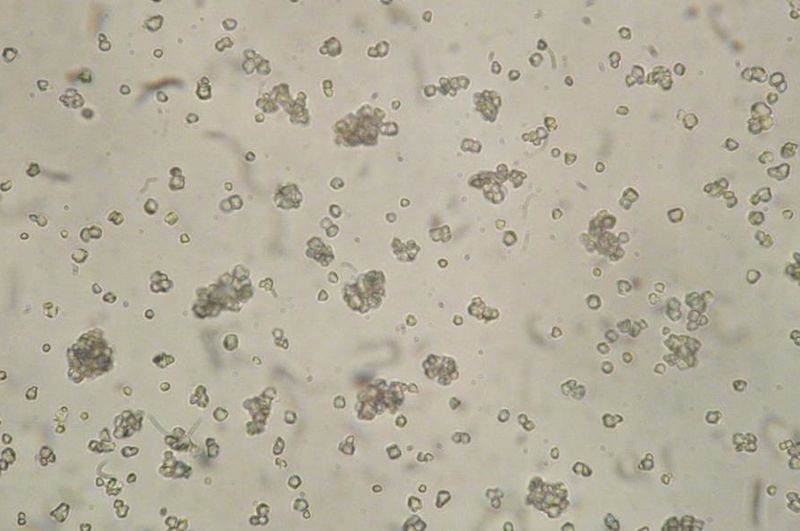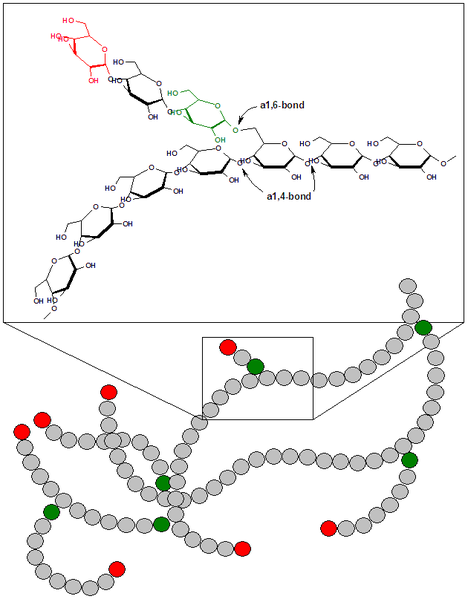What is the difference between cellulose, starch, and glycogen?
Cellulose, starch, and glycogen are three polysaccharides found in the living cells. These carbohydrates polymers comprise monomers of glucose.
Learning the difference between cellulose, starch, and glycogen will help a student to have a deeper understanding.
We have provided information that describes the difference in structure between cellulose, starch, and glycogen both in tabular and point form.

What Is Cellulose?
Cellulose is polysaccharides that are made up of thousands of glucose units. It is regarded to be the main component of cell walls in plants.
Cellulose tends to be a long and straight-chain polymer that contains one 4-beta glycosidic bond that combines various units of glucose.
The hydroxyl group in the straight chain of the polymer is held together by hydrogen bonds. Cellulose fiber is formed when several cellulose chains get together.

What Is Starch?
Starch is the main polysaccharides synthesized by green plants where glucose is produced and stored as a simple organic compound.
The glucose manufactured is stored in plants as oils, fats, and starch which are insoluble compounds. This implies that they do affect water potential in living cells.
The stored starch in plants is later converted into cellulose. Starch tends to occur in amyloplasts which are arranged into semi-crystalline structures.
Amylose and amylopectin are the main types of starch. They tend to differ in terms of arrangement and general structure.

What Is Glycogen?
Glycogen is polysaccharides stored in fungi and animals. It is normally regarded as the analog of starch. They tend to have some close similarities with amylopectin but a different structural arrangement.
The linear chains of glycogen tend to form one 4-alpha glycosidic bonds and several branches. The granules of glycogen occur in Cytosol of the cells. Liver and muscle cells are responsible for glycogen storage.
Therefore, glycogenolysis is the process where glycogen is broken down into glucose by glycogen phosphorylase. This process happens only when the body is in need of glucose.

Comparison Chart: Cellulose vs Starch Vs Glycogen
| Basic Terms | Cellulose | Starch | Glycogen |
| Occurrence | Fibers | Grains | Small Granules |
| Function | The building of cell walls and other cellular structures. | Serve as carbohydrate energy stored. | Carbohydrate energy stored during starvation. |
| Found in | Plants | Plants | Animals and Fungi |
| Molecular mass | 162.1406 g/mol | Variable | 666.5777 g/mol. |
| Molecular Formula | (C6H10O5)n. | (C6H10O5)n. | C24H42O21. |
| Nature of the Chain | Tend to be a straight, long and unbranched chain | Amylose is an unbranched and coiled chain. Amylopectin is a long chain and coiled. | Tend to be short, branched, and coiled. |
| Bond Between Monomers | 1,4 glycosidic bonds occur between the monomers of cellulose. | Amylose has 1,4 glycosidic bonds. Amylopectin has 1,4 and 1,6 glycosidic bond | 1,4 and 1,6 glycosidic bonds |
| Monomer | Beta glucose | Alpha glucose | Alpha glucose |
| Solubility in water | Insoluble | Amylose is soluble while Amylopectin insoluble | Soluble |
Core Differences Cellulose, Starch and Glycogen In Point Form
- Cellulose is organic compounds found in plants, starch act as chief carbohydrate reserve in animals and glycogen is found in animals as well as fungi.
- Cellulose has a molecular mass of 162.1406g/mol, that of starch is variable and that of glycogen is 666.5777 g/mol.
- Cellulose is insoluble in water, amylose starch is soluble whereas amylopectin is insoluble and glycogen is soluble.
- Cellulose tends to have an H-bonds with the adjacent chains, starch has coiled and unbranched chains whereas glycogen have short and highly branched chains.
- Starch occurs in grains, cellulose in fibers, and glycogen in small granules.
- Starch serves as a carbohydrates energy store, cellulose involves in the building of cellular structures and glycogen serves as a carbohydrate energy store
- Starch and cellulose are found in plants while glycogen in animals and fungi
- The molecular formula of starch is (C6H10O5)n Cellulose is (C6H10O5)n and glycogen are C24H42O21.
Frequently Asked Questions
- How is Glycogen Similar to Starch?
Both are the storage form of glucose. But Glycogen is the carbohydrate storage form in animals and starch in plants.
- What is the Basic Structure of Cellulose?
It is composed of a long chain of at least 500 glucose molecules. Hence is classified as a polysaccharide.
- Why is Glycogen Better than Starch?
It is more highly branched than most starches from plants. The high degree of branching in glycogen keeps it from crystallizing.
- Why is Cellulose Stronger than Starch?
They are linked together such that alternating molecules are rotated 180 degrees from each other. The parallel cellulose fibers stack up just like corrugated sheets piled on top of each other.
You May Also Like:
- Difference between Carbohydrates and Fats
- Difference between Animal Fats and Plant Fats (Oils)
- Difference between Macronutrients and Micronutrients
Comparison Video
Conclusion
Cellulose, starch, and glycogen are the main polysaccharides quite common in living organisms. They tend to differ in terms of storage, structure, properties, function, and sources.
The article above has outlined some of the core differences between cellulose, starch, and glycogen. I hope the difference between starch and glycogen in tabular form has been useful.
More Sources and References